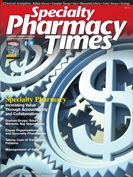Publication
Article
Specialty Pharmacy Times
Bristol-Myers Squibb's Orencia
Author(s):
The FDA approved a subcutaneous formulation of Bristol-Myers Squibb's Orencia (abatacept) for the treatment of moderately to severely active rheumatoid arthritis in adults.
The FDA approved a subcutaneous formulation of Bristol-Myers Squibb's Orencia (abatacept) for the treatment of moderately to severely active rheumatoid arthritis in adults.
The FDA has approved a subcutaneous (SC) formulation of Bristol-Myers Squibb’s Orencia (abatacept) for the treatment of moderately to severely active rheumatoid arthritis (RA) in adults, either as monotherapy or in combination with disease-modifying antirheumatic drugs (DMARDs) other than tumor necrosis factor (TNF) antagonists. 1
The intravenous (IV) formulation of Orencia was approved in 2005 for the same indication as the SC formulation, along with an additional indication as monotherapy or in conjunction with methotrexate for moderately to severely active polyarticular juvenile idiopathic arthritis in patients 6 years and older. 1,2 Both indications carry the limitation that Orencia should not be administered with TNF antagonists. 1 In the United States, it is estimated that RA affects 1.3 million adults and 300,000 children. 3 Approximately 75% of patients diagnosed with the condition are women. 2
PHARAMACOLOGY AND PHARMACOKINETICS
Orencia is a selective T cell costimulation modulator. Neither age nor gender affected the pharmacokinetics of Orencia. No formal studies have evaluated the impact of either renal or hepatic impairment on the pharmacokinetics of Orencia. 1
DOSING AND ADMINISTRATION
Orencia IV should be dosed by patient weight as follows:
•Less than 60 kg: 500 mg
• 60 to 100 kg: 750 mg
• More than 100 kg: 1000 mg
After the initial dose, subsequent IV doses should be given at 2 and 4 weeks, and then every 4 weeks thereafter. The solution should be administered as a 30-minute infusion and should be prepared with a silicone-free disposable syringe. Only sterile water should be used for reconstitution of the powder and the final product must be administered with a filter. Orencia SC should be given after 1 IV loading dose of Orencia per the weightbased guidelines. The first 125-mg SC dose should be given within a day of the IV dose, followed by weekly SC doses of 125 mg. Patients unable to receive the IV infusion can initiate SC treatment without the IV loading dose.
Patients aged 6 to 17 years with juvenile idiopathic arthritis should receive a 10-mg/kg/dose as an IV infusion. Patients weighing 75 kg or more should be dosed by the adult dosing guidelines, with a maximum dose of 1000 mg. After the initial dose, subsequent IV doses should be given at 2 and 4 weeks, and then every 4 weeks thereafter. Each infusion should be given over 30 minutes. Unused solution should be discarded immediately. 1
CLINICAL TRIALS
Orencia SC was evaluated in a randomized, double-blind, double-dummy, multinational trial to determine the noninferiority of Orencia SC plus methotrexate (MTX) to Orencia IV plus MTX. The trial consisted of 1457 patients with moderate-to-severe RA; most study participants had not responded adequately to MTX alone. The SC arm received a single IV loading dose of Orencia, followed by Orencia 125 mg SC weekly plus MTX. The IV arm received MTX plus Orencia IV per the weight-based dosing guidelines on day 1, 15, 29, and every 4 weeks thereafter. At the end of the 6-month study, each arm experienced comparable response rates. 2
CONTRAINDICATIONS, WARNINGS, AND PRECAUTIONS
There are no contraindications to treatment with Orencia.
Orencia should not be given to patients concomitantly using a TNF antagonist, as this combination may increase the risk of serious infections. Hypersensitivity, anaphylaxis, and anaphylactoid reactions may occur during treatment with Orencia. Patients who have a history of recurrent infections or underlying conditions predisposing them to infections may experience more infections while using Orencia. Orencia should be discontinued if a serious infection occurs. Patients should be screened for latent tuberculosis (TB) infections prior to initiating treatment with Orencia; patients who test positive should be treated for TB before beginning Orencia.
Live vaccines should not be given during treatment with Orencia or within 3 months of discontinuation of Orencia. Pediatric patients should be brought up-to-date on all vaccinations prior to treatment with Orencia. Orencia may blunt the effectiveness of some immunizations. Patients with chronic obstructive pulmonary disease may develop more frequent respiratory adverse effects. Orencia is Pregnancy Category C and should not be used while breast-feeding.
The most common adverse effects (≥10%) are headache, upper respiratory tract infection, nasopharyngitis, and nausea. 1
References
1. Orencia complete prescribing information. http://packageinserts.bms.com/pi/pi_orencia.pdf. Accessed December 2011.
2. U.S. Food and Drug Administration approves subcutaneous formulation of ORENCIA (abatacept), a proven non-anti-TNF biologic for adults with moderate to severe rheumatoid arthritis. www.bms.com/news/press_releases/pages/default.aspx. Accessed December 2011.
3. The Arthritis Foundation. www.arthritis.org/who-gets-rheumatoid-arthritis.php. Accessed December 2011.
About the Author
Monica Holmberg, PharmD, BCPS, is a pharmacist who resides in Phoenix, Arizona.







